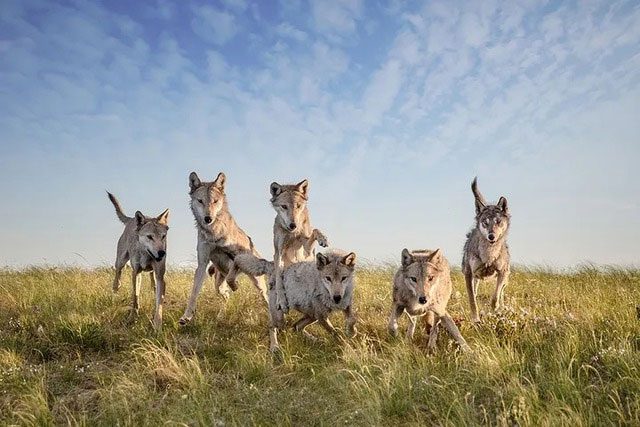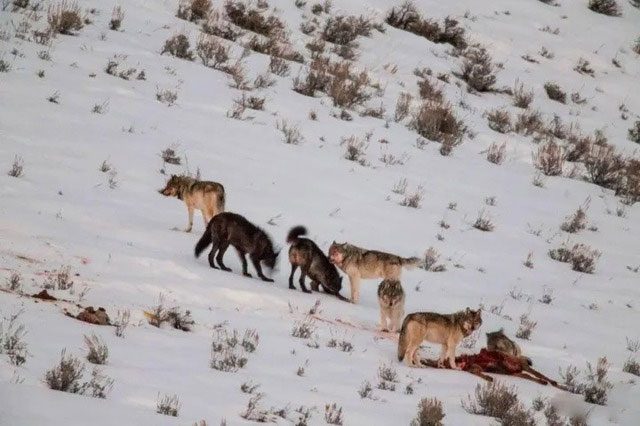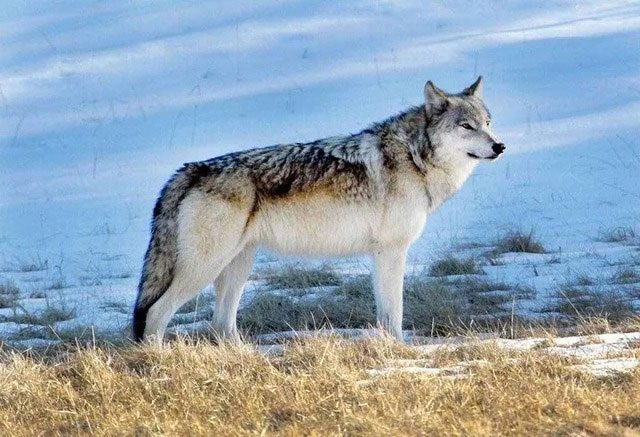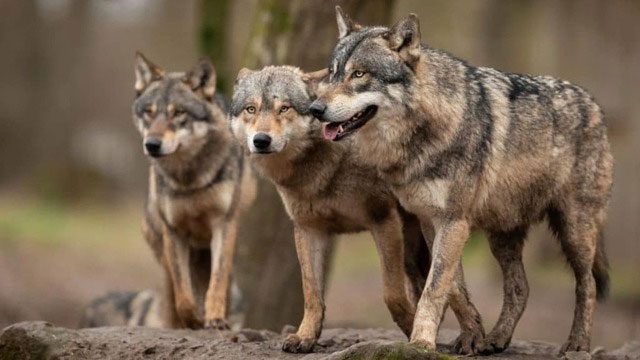The gray wolf is known to be one of the most successful mammal species, widely distributed across the Northern Hemisphere, from Eurasia to North America. Wolves are considered highly social animals, living in packs and acting in unison, creating well-organized and disciplined groups, which are regarded as a formidable presence in nature.
The fate of gray wolves varies depending on their habitat, for instance, in North America, they are seen as the kings of mammals, dominating the local area. However, in Northeast Asia, gray wolves are often overpowered by Siberian tigers, and their population growth is severely inhibited by the presence of these big cats. What accounts for this disparity?
Open Areas Favor the Formation of Large Wolf Packs

Gray wolves in different regions have different fates.
As we know, a solitary wolf is not particularly fearsome, but a pack of wolves is often invincible; thus, the key factor is whether wolves can form large packs in a given area.
North America’s terrain is primarily divided into three major geographic columns: the high mountains to the west, vast plains in the center, and low plateaus to the east. Generally, the terrain of North America is relatively flat, and open areas often facilitate the formation of large wolf packs.
Wolves are not faster than some hoofed animals; in open areas, they find it challenging to chase down prey, but a pack of wolves can easily capture prey through coordinated pursuit and blocking.
Another significant reason for the dominance of wolves in North America is the absence of stronger predators in the region. In Northeast Asia, the Siberian tiger is a formidable presence, while in the Americas, the jaguar is primarily found in Central and South America, the cougars in North America, and coyotes are generally smaller and less robust than gray wolves.

The gray wolf in North America is the largest species of gray wolf in the world.
In open areas, the advantages of hunting in packs are evident compared to solitary hunting, which is why solitary predators like tigers struggle to thrive in such environments. Benefiting from pack hunting, gray wolves in North America can form quite large packs.
Smaller packs may have over a dozen members, while larger packs can even consist of hundreds. Furthermore, the gray wolf in North America is the largest gray wolf species in the world, particularly those in the Mackenzie region of Canada, which can grow to the size of a pony when fully mature.
Grizzly bears can fight fiercely, but they are not traditional predators, and competition with gray wolves is not particularly fierce. In contrast, in Northeast Asia, the competition between Siberian tigers and gray wolves is very intense.
Gray wolves have a wide distribution, so the differences in size among various subspecies living in different regions are quite pronounced. For example, European forest wolves are comparable in size to small or medium domestic dogs and cannot be compared to North American gray wolves.
Researchers from the Belarusian Academy of Sciences have conducted long-term ecological studies in the Naliboki forest and found that the Eurasian lynx actively preys on gray wolves there. Besides wolf pups, many adult solitary wolves are also killed by lynxes, primarily because these wolves are not very large.

In Northeast Asia, Siberian tigers and gray wolves have a close competitive relationship.
Gray Wolf Population Growth Inhibited by Tigers
Theoretically, the forest environment and smaller subspecies of gray wolves make them less advantageous when competing with Siberian tigers. We can also examine the population trends of Siberian tigers and gray wolves in conjunction with historical data for accurate insights.
An ecological study in the Sikhote-Alin mountains shows that the top three prey of tigers are: red deer, wild boar, and sika deer; while the top three prey of gray wolves are: red deer, sika, and wild boar. Gray wolves are very similar to Siberian tigers in terms of hunting range and preferences, making fierce competition unavoidable.
Before the 20th century, the population of Siberian tigers in the entire region radiating from the Stanovoy mountains was significant, while the local gray wolf population was very low, and its growth was stagnant. It wasn’t until the late 19th century that Russia began large-scale hunting of tigers, leading to a drastic decline in Siberian tiger numbers, after which the local gray wolf population started to grow significantly.
By the 1940s, the population of Siberian tigers reached a historical low, while the gray wolf population subsequently reached record highs. The 1940s were a turning point because in 1947, Russia recognized the importance of tigers, instituted a comprehensive hunting ban, and began strong protection efforts.
By the late 1980s, the Russian tiger population had stabilized at a relatively high level. During the period of increasing tiger populations, gray wolf numbers began to decline, and after the 1990s, gray wolves became very rare across the Russian Far East; indeed, from 1992 to 1993, no gray wolf sightings were reported.

Fewer tigers lead to more gray wolves, while more tigers lead to fewer gray wolves.
By assessing the population trends of both species, we can clearly see that there is a relationship between the number of Siberian tigers and gray wolves. The fewer tigers there are, the more gray wolves there are; the more tigers there are, the fewer gray wolves there are.
In summary, why do gray wolves dominate North America but are defeated in Northeast Asia?
- First is the environmental reason; the open terrain of North America favors the formation of large wolf packs.
- Second, the gray wolves in North America are a larger subspecies, and besides their strength, there are no competitors that can match them.
In contrast, in Northeast Asia, aside from the unfavorable conditions for forming large wolf packs, the dense forest environment also provides them with top natural predators that are very hostile to the existence of gray wolves.


















































